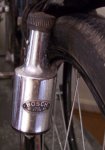NOBODY claimed a free lunch, with ANY of the arguments.
I went back and re read the posts. You are correct. No one claimed a free lunch. Just a different way to make electricity.
Why we may need such a thing or not was not part of the OPs discussion.
However, there just may be an application for this idea.
Take a look at the valve stems for any vehicle made after '08. See the big, expensive, black box that goes on the inside of the rim? That is a pressure sensor with a radio in it. The radio sends signals to the instrument panel for tire pressure and most importantly, to activate the low pressure warning light. These devices have to have a power source. They are called dTPMS devices.
From Wiki:
Most originally fitted dTPMS have the sensors mounted on the inside of the rims and the batteries are not exchangeable. With a battery change then meaning that the whole sensor will have to be replaced and the exchange being possible only with the tires dismounted, the lifetime of the battery becomes a crucial parameter. To save energy and prolong battery life, many dTPMS sensors hence do not transmit information during standstill at all or apply a complex and expensive two-way communication which enables an active wake-up of the sensor by the vehicle.
So, you can see that battery life is a major design concern. No battery lasts forever, and the sensors are $70 each, not including installation.
Using electricity generated from the tires would mean that the batteries could be eliminated. A capacitor could store enough energy for one or two read outs while the vehicle is stopped. Once the vehicle starts to move, the tires could re-charge the caps and supply energy for monitoring while in motion.
Since the tires are not moving relative to the sensors, this makes them a great source of energy that would not require any form of sliding contact, brushes, etc. to get the energy to the sensors.


